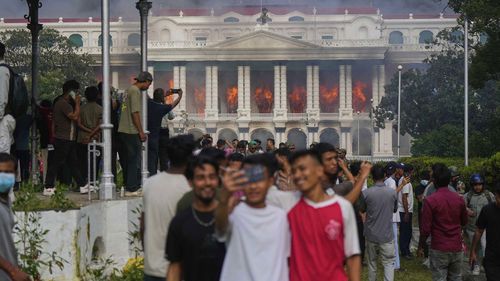Share this @internewscast.com
Youths from Kathmandu to Lima are stepping away from their screens, taking to the streets to lead uprisings that demand accountability, spur change, and sometimes result in the overthrow of governments.
These Gen-Z protesters come from disparate backgrounds and have different demands.
The message is clear: Increasing inequality and marginalization are eroding young people’s hopes for their future, and the only solution is to address a fractured social contract directly.

And it adds to youth-led protests across Indonesia, the Philippines and Kenya this year.
Subir Sinha, director of SOAS South Asian Institute, noted the link between various Gen Z-led protests across the Global South.
The interests of ruling elites appear distant from the everyday lives, concerns, and anxieties faced by Gen Z, highlighting a grim economic future for many, as reported by CNN.
“There is a kind of a catastrophic feeling around, with a kind of end days of liberal democracy (felt) in country after country,” he said.
Gen Z, individuals born between 1997 and 2012, matured through the repercussions of the 2008 financial crisis. As adults, they face deeper political divisions, an escalating climate crisis, economic instability, and a pandemic that has intensified deep-rooted inequalities.
Bart Cammaerts, a professor at the London School of Economics, indicated to CNN that this generation feels “short-changed,” with their interests overlooked or ignored.
Consequently, Cammaerts observed that Gen Z is skeptical of liberal representative democracy, although they still uphold democratic values and the importance of democratic decision-making.
The protests that are now unfolding are a result of that skepticism.
The rise of authoritarianism, xenophobia and nationalism is also fueling young people’s desire to act, as opportunities that were once available to their parents’ generations have nearly disappeared.
“The exit option of at least temporary migration has been closed as a part of the authoritarian age we are living in,” Sinha said.
It is also no surprise that the countries where this unrest is unfolding are experiencing the brunt of major extreme weather events, he said, where older generations are in power and often taking inadequate steps to stop global warming from getting worse.
For young people, “the idea of the future being cancelled appears to be very real – and I think that is partly the sort of contagion we see,” Sinha said.
As traditional forms of challenging political discontent become more challenging, Gen Z are looking to their peers in other countries for a roadmap.
“When they see that somewhere else has had a similar kind of situation, and people have had some degree of success … they might feel, let’s try this out over here,” Singh said, pointing to Nepal’s recent demonstrations.
“It’s as if they’re holding each other’s hands across national borders.”
For as long as there’s been protest, young people have been leading the charge. From the student-led uprisings of May 1968 in France to the Vietnam War demonstrations and Civil Rights Movements in the United States – to the Occupy movement and the Arab Spring, youths have always played a central role in driving change.
Gen Z are no different. They’ve just got different tools to organise and mobilise.
They have transformed activism over digital platforms like Instagram, TikTok, Discord – a messaging app first popularised by gamers – and Telegram. These tools enable decentralised, real-time coordination, rapid information sharing, and viral symbols that unify diverse groups from across the globe.
“You don’t need necessarily a big organisation or mobilising force,” Cammaerts said of the protesters’ tactics.
That’s because they’re all online.
For example, in Morocco, the anonymous Discord server “GenZ 212” grew from 3000 members to more than 130,000 in just a few days, Reuters reported, exemplifying how quickly an online presence can materialise into the streets.
That sort of online capability allows protests to be more spontaneous, decentralised and leaderless, making them harder for authorities to dismantle, and therefore appealing to young people who are sometimes risking their lives to demonstrate, Cammaerts said.
“The online infrastructure facilitates that,” he said.
In Madagascar, an online youth-led movement known as Gen Z Mada first coordinated over Facebook and TikTok before organising with more traditional civil society groups and trade unions.
When Gen Z’s digital protests manage to cut through class and generational lines they gain further momentum, power and the ability to drive greater change, Sinha said.
“When they do that, then it becomes not just a Gen Z thing … it goes beyond that, and it becomes a much bigger kind of movement altogether,” he said.













